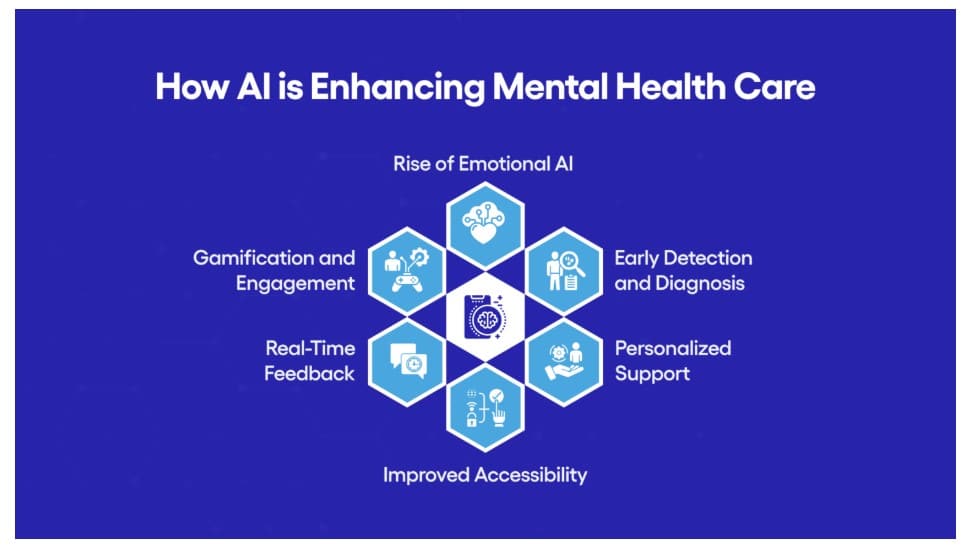What if AI could handle 80% of your daily tasks?
AI is changing how remote work happens. It’s making business operations faster, smarter, and easier. With tools like virtual assistants and automation, teams can work more efficiently from anywhere.
Over 51% of remote workers believe AI will take over most of their current tasks. That’s because AI is transforming project management and everyday workflows.
As AI keeps evolving, it’s boosting innovation and productivity. This blog explores why AI is important and 6 powerful ways it’s shaping the future of remote work.
The Growing Need for AI in Remote Work
The growing demand for quick service and instant solutions has pushed organizations to integrate with emerging technology and build AI-led work systems.
With its ability to analyze big data through deep learning, machine learning, and natural language processing, businesses can:
- Explore new applications
- Conduct market research campaigns
- Develop AI-powered products & services
- Automate decision-making
- Enhance customer experiences
For startups, this opens new doors. It also makes remote training and team collaboration much easier. Moreover, AI-generated reports are another factor behind the growing need for AI.
Reports generated by humans might have errors, but AI-generated reports are meticulous and eliminate human errors. This boosts productivity in remote teams by tracking progress, spotting problems early, and improving workflows.

McKinsey reports generative AI’s potential to increase labor productivity from 3% to 4% annually at a midpoint adoption scenario. The key areas that increase the need for AI are:
- Chatbots: Chatbots leverage AI (machine learning and natural language processing) to stimulate human-like conversations.
- Cybersecurity: AI detects threats and automates incident responses in real-time to mitigate risks.
- Project management: AI analyzes project data, identifies bottlenecks, and predicts resource requirements.
- Personalization: AI customizes job descriptions and training programs, catering to each employee’s role and skill set.
A prime example of AI in remote work is NVIDIA. The NVIDIA AI Workbench enables developers and data scientists to create, collaborate, and transfer AI projects seamlessly across local PCs, workstations, data centers, and cloud systems.

This shows AI is no longer a good to have but necessary to empower remote work. It plays a vital role in reshaping the future of remote work and the emergence of AI-first businesses.
6 Key Ways AI Is Reshaping the Future of Remote Work
1) AI-powered productivity tracking and workforce management
AI tools help remote teams stay organized and efficient. From tracking time to managing tasks, AI acts like the glue that holds everything together.
Managing large teams demands frequent meetings, constant program scheduling, and regulated payroll. You can implement AI to handle the specifics so you can focus on the bigger picture.
AI’s advanced algorithms manage appointment calendars, allocate projects, customize training programs, and monitor employee performance. This enhances productivity and streamlines workforce management. The key components include:
Time tracking
AI tracks user actions in real-time and generates accurate reports, reducing human errors. This keeps you updated about remote productivity and ensures minimal scheduling efforts.
Allocating tasks
Using machine learning, AI understands an individual’s skill set, employee availability, and workload management abilities to assign important tasks. This prevents burnout and encourages fair distribution of tasks.
Attendance management
Keeping track of attendees manually is time-consuming and often unregulated. AI-powered online attendance tracking software tracks attendance, sends reminders, and generates absent reports.
2) Smart communication and collaboration tools
AI plays a vital role in streamlining communication through AI-driven real-time translation, speech-to-text transcriptions, and content summarization.
The primary benefit is the elimination of language barriers and time-zone gaps in global teams. Popular tools like Slack and Microsoft Teams leverage AI to record meetings and automate taking important notes. Other crucial features include:
Intelligent meeting assistance
AI tools record meetings and highlight key information, reducing the time spent on analyzing less critical updates.
Smart notifications and prioritization
AI examines participants’ profiles, communication patterns, and job roles to identify priority messages and filter out not-so-important data.
Enhanced collaboration
Platforms like Monday.com automate task allocation, send reminders, and keep the team organized. This is done by summarizing meetings, automating responses, and generating daily reports.
3) Personalized learning and employee development
Zippia reports that 86% of remote workers experience burnout. A big reason behind these burnouts is unappealing online training programs.
By implementing AI, you can analyze employee skill sets, learning patterns, and areas for improvement. Based on the analysis, AI customizes courses, provides training insights, and personalizes the skill development journey. Let’s break it down:
Identifying skill gaps
AI examines the worker’s current skill set, performance data, and career aspirations to identify skill gaps. Courses are created to target weak areas requiring immediate attention.
Implementing virtual coaches
AI-driven virtual mentors offer 24/7 guidance, give unbiased feedback, and answer questions in real time. This acknowledges employees throughout their learning journey.
Data-driven insights
By leveraging performance data and employee progress reports, AI refines training strategies to align employee development goals with business objectives.
4) Automation of repetitive tasks
The most prevalent feature of AI is automating repetitive tasks—scheduling meetings, generating reports, data entry, and handling customer inquiries. This helps remote workers focus on innovating creative strategies to tackle complex issues.
However, task automation goes beyond saving time and effort, it improves work performance, productivity, and job satisfaction. The key areas for AI-powered automation include:
Data entry
AI-powered systems extract information from documents like invoices, receipts, and forms, and input it into databases or spreadsheets automatically, reducing manual data entry efforts.
Communication management
Using machine learning, AI filters emails, segments messages, and automates responses, encouraging professionals to be proactive. This handles day-to-day conversations and saves time.
Customer support
Chatbots and virtual assistants driven by AI scan customer profiles and use natural language processing to communicate like humans. It also manages FAQs, customer inquiries, and provides 24/7 customer support.
5) AI in mental health and well-being support
Although remote work gives you the freedom to keep the laptop on your lap, it is very demanding. The day is packed with tight deadlines, frequent meetings, and a heavy workload. This poorly affects mental health, leading to increased workplace stress.

But how does AI support mental health? Let’s see:
Early stress detection
Emotional AI examines facial expressions, body language, and voice patterns during live meetings to detect stress. It even suggests stress-relieving exercises, recommends uplifting content, and compels you to take breaks.
Access to mental health support
AI-powered systems offer guidance, emotional assistance, and resources without human intervention. For example, Ginger.io leverages behavioral insights to track symptoms and connect with mental health resources.
Building resilience skills
AI-led Employee Assistance Programs (EAPs) incorporate cognitive behavioral therapy (CBT) strategies, allowing workers to reprogram negative thinking. Such systems enhance mood, resilience, and productivity.
Telemedicine
AI delivers telemedicine services by connecting employees with nutritionists, psychiatrists, and other mental health specialists based on their mental health.
6) AI-driven decision making and performance analytics
43% of CEOs use generative AI to make strategic decisions. Decision makers leverage AI to examine large data sets and monitor media services, enhancing team performance through predictive analysis.
The role of AI in decision making highlights:
Real-time insights
AI algorithms identify patterns, trends, and anomalies that human decision-makers overlook, providing actionable insights. This helps remote teams make informed decisions quickly in real time.
Performance monitoring
AI tools track employee productivity to provide detailed analytics of individual and team performance. These insights help managers optimize workflows and allocate resources efficiently.
Predictive analysis
Machine learning models predict future trends from historical data, allowing organizations to anticipate challenges and opportunities. For example, predictive analytics can forecast project timelines and employee performance.
Embracing AI for an Efficient Remote Workplace
AI no longer plays on the sidelines, it has become the primary driver of remote work. Leveraging AI to automate tasks, personalize learning, enhance collaboration, and streamline workforce management simplifies adaptation to the ever-changing landscape of remote work.
Businesses now embrace AI in remote work to manage employee engagement, customer support, and workload stress.
Stay informed about the latest AI platforms to integrate them into your business. Start by exploring agilitypr.com and leverage generative AI to deliver smarter, faster, and impactful PR communications.



